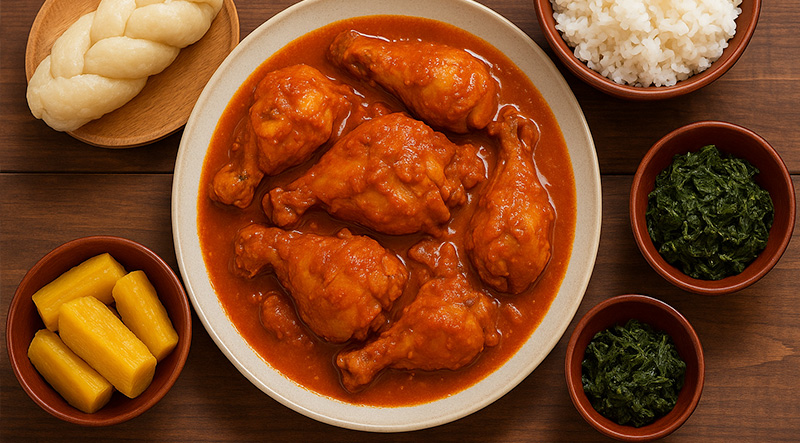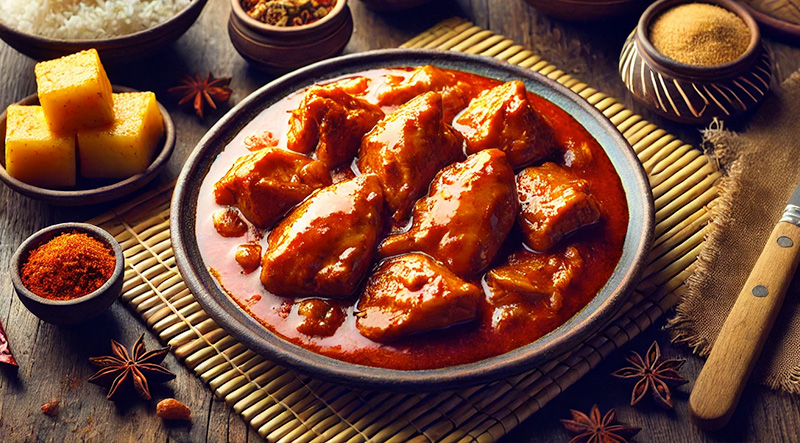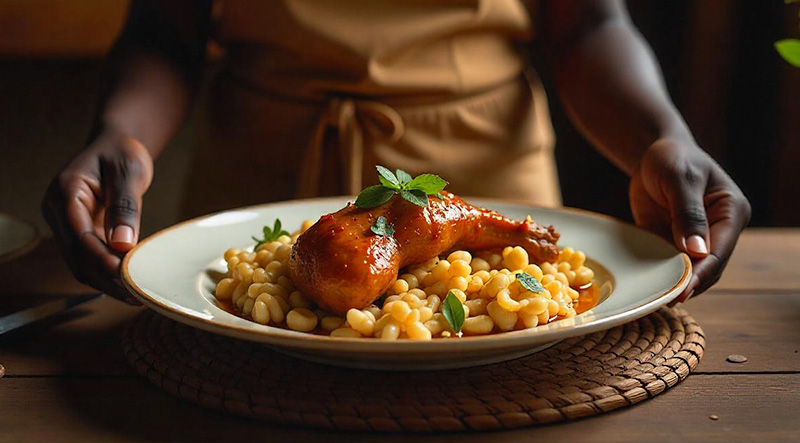Get ready to savor the bold and irresistible flavors of Poulet Nyembwe, the beloved national dish of the Republic of the Congo. This mouthwatering masterpiece features tender chicken slow-cooked in a rich, silky sauce made from palm nut pulp (nyembwe)—a vibrant red-orange delight that’s earthy, slightly smoky, and bursting with depth. Often paired with cassava, plantains, or rice, Poulet Nyembwe is more than just a meal—it’s a celebration of Congolese heritage on a plate, where every bite tells a delicious story of tradition, nature, and soul-satisfying flavor. Read More...
The History of Poulet Nyembwe – The National Dish of the Republic of the Congo:
Poulet Nyembwe, a savory chicken stew simmered in rich red palm nut sauce, stands proudly as the national dish of the Republic of the Congo. Known for its deep, earthy flavor and silky texture, this beloved dish reflects the country’s agricultural roots, traditional cooking techniques, and strong sense of cultural identity. Its name derives from “nyembwe,” meaning palm nut sauce in local Bantu languages, which is the soul of the recipe and a staple ingredient across Central Africa.
Ancestral Roots and Indigenous Cooking:
The origins of Poulet Nyembwe are deeply embedded in the traditional foodways of the Bantu peoples, who have lived in Central Africa for centuries. The palm tree, abundant in the region, has long been a vital resource—not just for its nuts but for its oil, wine, and wood. Generations ago, Congolese communities discovered that boiling and pounding the fruit of the oil palm tree produced a thick, golden-orange pulp—nyembwe—that was perfect for enriching stews.
Long before colonization, palm nut sauce was already a central part of local diets. Meats such as bushmeat, fish, or chicken were simmered in nyembwe to enhance both flavor and nutrition, creating hearty meals designed to sustain families through long days of farming, fishing, or travel.
Chicken Takes Center Stage:
While various proteins have traditionally been used in palm nut stews, chicken eventually became the favored meat for ceremonial and festive occasions. Its versatility and tender texture pair beautifully with the creamy, slightly oily palm sauce, creating a luxurious yet earthy dish. Over time, Poulet Nyembwe—chicken in palm nut sauce—emerged as a special-occasion food, often served at weddings, community gatherings, and family feasts.
Post-Independence Identity and National Pride:
When the Republic of the Congo gained independence from France in 1960, there was a renewed focus on reclaiming and honoring traditional culture. Poulet Nyembwe, already a staple in many Congolese homes, gained greater symbolic significance. It was increasingly seen as a dish that united people from different regions and ethnic backgrounds under one national identity. Its reliance on native ingredients, such as palm nuts, highlighted a return to roots and pride in local agriculture and culinary self-sufficiency.
A Regional Favorite with Local Flair:
While similar dishes exist in neighboring countries like Gabon, Angola, and the Democratic Republic of the Congo, Poulet Nyembwe in Congo-Brazzaville has its own distinctive touch. Some versions use fewer spices, allowing the natural richness of the palm sauce to shine, while others include chilies, smoked fish, or traditional herbs to give it a regional twist. It is often accompanied by cassava (chikwangue), rice, or boiled plantains, completing a hearty and satisfying meal.
From Village Fires to Modern Tables:
Today, Poulet Nyembwe remains a treasured dish across the Republic of the Congo. Whether simmered slowly over a village fire or served in an urban restaurant in Brazzaville, it continues to represent the soul of Congolese cuisine. For many, it’s a dish filled with nostalgia and pride—a flavorful reminder of home, tradition, and the enduring strength of cultural heritage.
In every spoonful of Poulet Nyembwe is a taste of Congo’s past and a celebration of its vibrant present.
Prepare the Chicken:
Sauté Aromatics:
Add the Palm Nut Sauce:

Combine and Simmer:

Final Touch:

Serving Suggestions – Serve hot with:
This hearty, soulful dish captures the essence of Congolese cuisine—earthy, satisfying, and full of cultural warmth. Poulet Nyembwe is not just food; it’s a taste of home, history, and heritage.
The total preparation and cooking time for Poulet Nyembwe is approximately 1 hour and 30 minutes. Preparation takes around 20–25 minutes, including cleaning and seasoning the chicken, chopping onions, garlic, and tomatoes, and preparing the palm nut sauce if using a fresh or frozen version. Cooking takes about 60–70 minutes, starting with browning the chicken, sautéing the aromatics, and then slowly simmering the chicken in the palm nut sauce until tender and richly flavored. If you're serving it with sides like cassava, rice, or plantains, allow an additional 15–20 minutes depending on the dish.
A single serving of Poulet Nyembwe, based on the recipe provided and assuming 6 servings, contains approximately 600–700 calories. This includes the calories from chicken (especially with skin), the rich and dense palm nut pulp, cooking oil, and any added ingredients like tomatoes and onions. Palm nut sauce is naturally high in healthy fats, which contributes significantly to the calorie count. If served with traditional sides such as cassava (chikwangue), rice, or plantains, the total can increase to around 800–900 calories per serving, depending on portion size. This makes it a filling and energy-dense dish perfect for a hearty meal.







